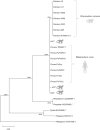Is zoonotic Plasmodium vivax malaria an obstacle for disease elimination?
- PMID: 36397077
- PMCID: PMC9673391
- DOI: 10.1186/s12936-022-04349-6
Is zoonotic Plasmodium vivax malaria an obstacle for disease elimination?
Abstract
Background: The groundwork for malaria elimination does not currently consider the potential of Plasmodium zoonotic cycles that involve non-human primates (NHPs) in sylvatic environments. Since vivax malaria is less responsive to control measures, finding Plasmodium vivax infected NHPs adds even more concern.
Methods: Both Free-living monkeys in forest fragments inside the urban area and captive monkeys from a local zoo had blood samples tested for Plasmodium species.
Results: In this study, among the Neotropical monkeys tested, three (4.4%), one captive and two free-living, were found to be naturally infected by P. vivax.
Conclusion: This important finding indicates that it is necessary to estimate the extent to which P. vivax NHP infection contributes to the maintenance of malaria transmission to humans. Therefore, the discussion on wildlife conservation and management must be incorporated into the malaria elimination agenda.
Keywords: Malaria; Malaria elimination; Non-human primates; Plasmodium vivax; Zoonotic cycle.
© 2022. The Author(s).
Conflict of interest statement
The authors declare that they have no competing interests.
Figures


References
-
- WHO. World Malaria R. 20 years of global progress and challenges. Geneva: World Health Organization; 2020. https://www.who.int/teams/global-malaria-programme/reports/world-malaria....
-
- WHO . Global technical strategy for malaria 2016–2030. Global Malaria Programme. Geneva: World Health Organization; 2015.
MeSH terms
Grants and funding
LinkOut - more resources
Full Text Sources
Medical

